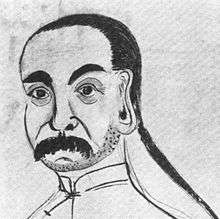Eight Trigrams uprising of 1813

The Eight Trigrams uprising of 1813 broke out in China under the Qing dynasty. The rebellion was started by some elements of the millenarian Tianli Sect (天理教) or Heavenly Principle Sect, which was a branch of the White Lotus Sect. Led by Lin Qing (林清; 1770–1813) and Li Wencheng, the revolt occurred in the Zhili, Shandong, and Henan provinces of China.
In 1812, the leaders of the Eight Trigram Sect (Bagua jiao) also known as the Sect of Heavenly Order (Tianli jiao) announced that leader Li Wencheng was a 'true lord of the Ming' and declared 1813 as the year for rebellion.[1]
The group won support from several powerful Eunuchs in the Forbidden City. On 15 September, 1813, the group attacked the imperial palace in Beijing. The rebels made it into the city, and may have been successful in overthrowing the Qing had not Prince Mianning—the future emperor—used his forbidden musket to repel the invaders.[1]
The rebellion is seen as being similar to the previous White Lotus Rebellion, with the former being of religious intent and the latter leaders of the Eight Trigram appearing more interested in personal power by overthrowing the Manchu dynasty.[1]
History
Leading up to Rebellion
Leaders Lin Qing (林清; 1770–1813) and Li Wencheng seemed to have been inspired to overthrow the Qing by the appearance in 1811 of a bright comet. Although Beijing claimed that this comet showed great glory for the dynasty, Lin and Li saw this as an "auspicious blessing for their enterprise" to overthrow the dynasty. They divided their followers into eight groups, or trigrams, and gathered contributions by promising future benefits after the rebellion was successful: "It was promised that when Li Wencheng has risen up, everyone who had given money or grain would be given land or official rank."[1]
During July 1813, the main leaders of the Eight Trigrams met to set a date for the rebellion. They were prompted by droughts and floods, as well as by sharp increases in the price of wheat, and set 15 September as an appropriate time for the rebellion to begin. In addition to being right after the harvest, the Jiaqing Emperor was scheduled to be out of Beijing, so the Forbidden City would be lightly guarded. The plan was that when Jiaqing returned to Beijing, they would attack him outside the city and assassinate him.[1]
Beijing officials heard rumors of the planned rebellion and arrested Li Wencheng on 2 September. Officials tortured Li, but before they hurt him too seriously, Li's followers broke in and released him. This event pushed forward the date of the rebellion, and by 6 September, the members were busy collecting weapons. Followers of the Eight Trigrams quickly took control of the towns of Huaxian, Caoxian, Dingtao in southern Zhili and Shandong provinces.[1]
Assault of Forbidden City
Lin Qing was in charge of the attack on the Forbidden City, although he personally did not participate in the attack. Lin enlisted several palace eunuchs to lead his approximately 250 followers through the gates. To distinguish themselves, the rebels tied white cloth around their heads and waists. Armed with knives and iron bars, they planned to enter the Forbidden City at noon, when the guards would be eating their meals. In addition, the Jiaqing Emperor was less than fifty miles from the city walls. This plan met with mixed success and about eighty rebels made it through the gates before they were closed. Fighting soon erupted as the Manchus realized that the rebels were inside the gates. It was at this time that Prince Mianning joined the battle and used his musket to wound one rebel and to kill another.[1]
Aftermath
With the advantage of surprise lost, the rebels turned and fled. Under the leadership of the Ti Prince the princes Cheng, Mianzhi, Mianning, as well as officers of the Imperial Guards Brigade and loyal eunuchs, the surviving rebels were hunted down.
Li Wencheng, along with 4000 supporters, withdrew to Huixian. He self-immolated and died while besieged by Qing troops. His wife Li Zhangshi kept Huaxian until the following year when she hung herself as the city fell.
During the battle at the Forbidden City, a total of thirty-one rebels were killed and forty-four captured alive, but before it was over the rebels had either murdered or injured over a hundred people in the palace. By the time the government suppressed the revolt, more than 20,000 Eight Trigrams members had been killed.[1]